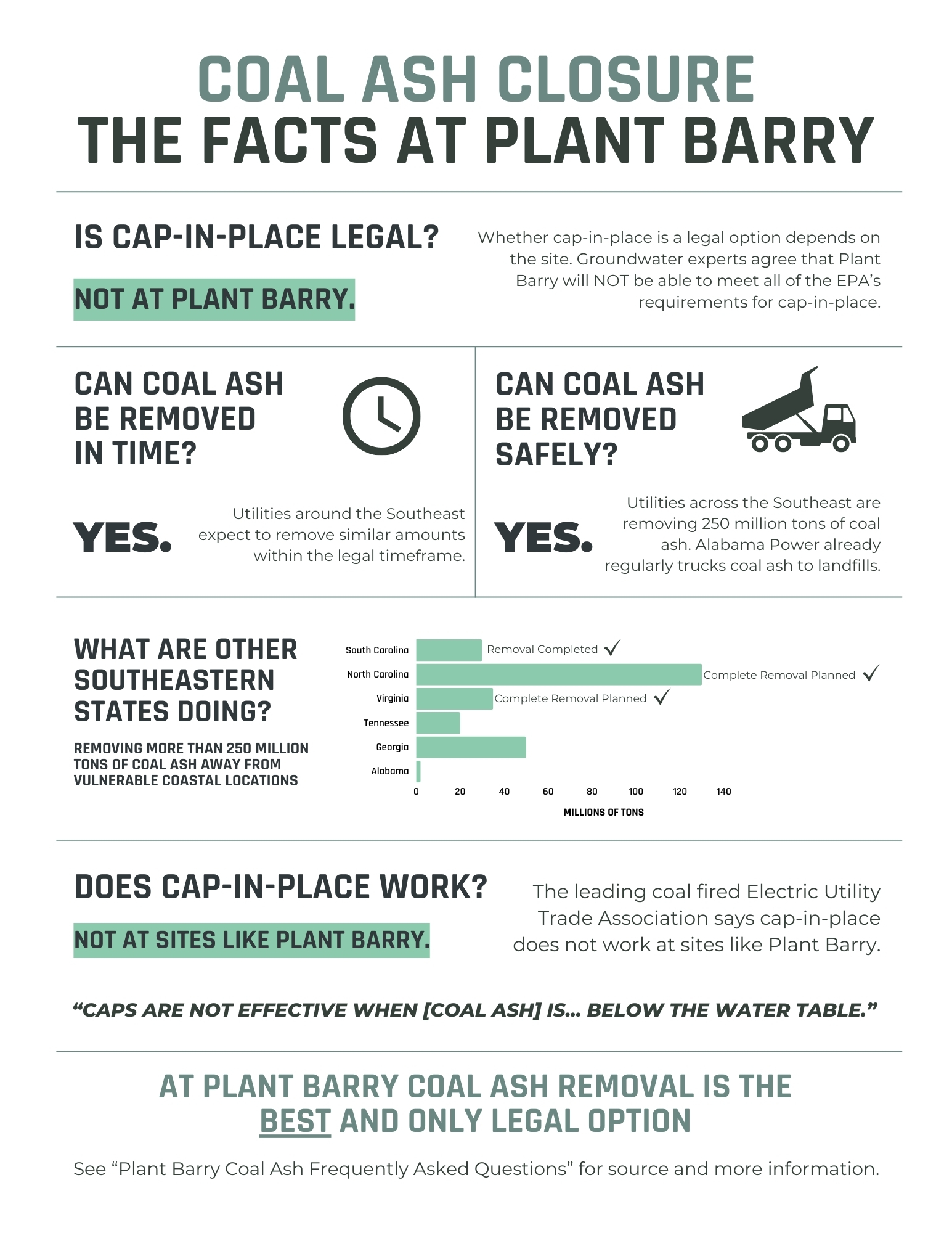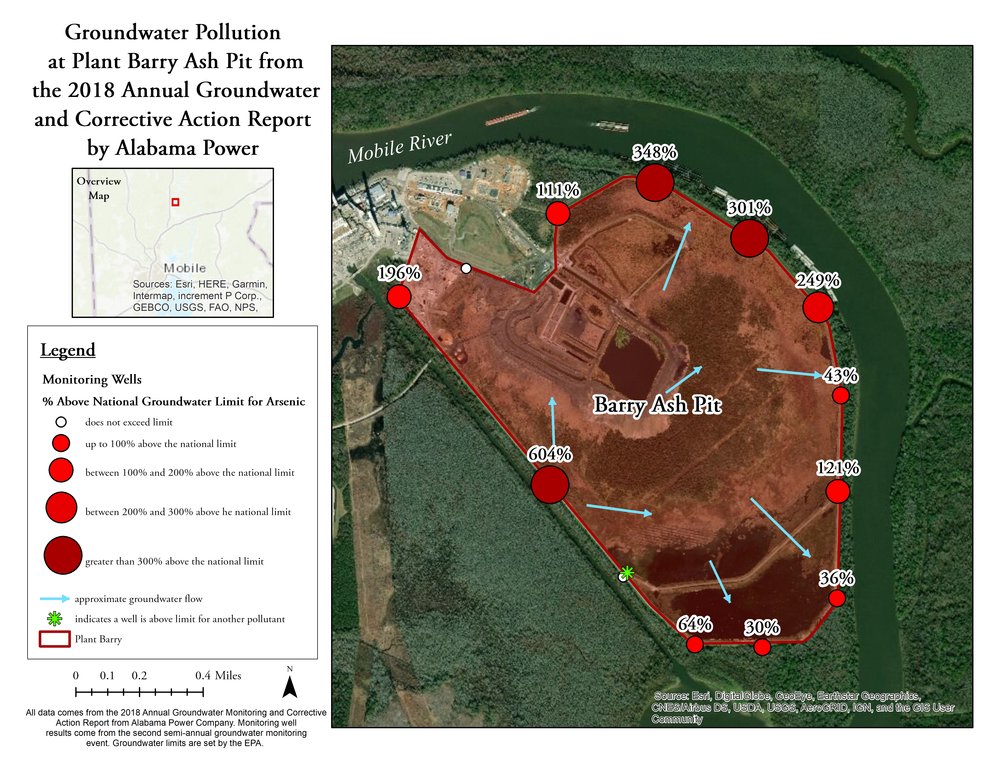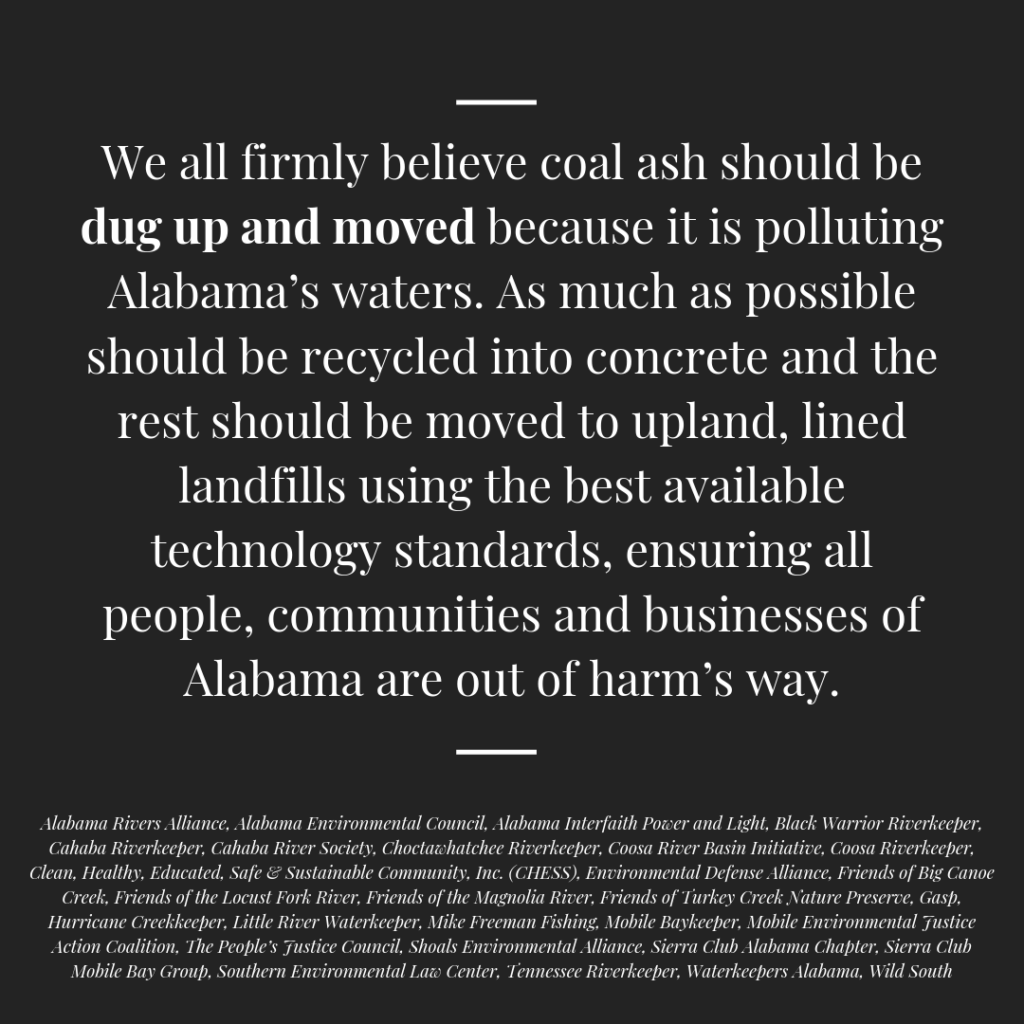August 2023
Here’s the rundown

Power plants typically mix the ash with water and dump it in massive “ponds” or pits nearby. Toxic pollutants commonly found in coal ash include heavy metals such as arsenic, mercury, selenium, chromium, and lead, which are hazardous to human health, wildlife, and waterways. A report by a physician-led non-profit found that coal ash pits can leach toxic constituents thousands of times greater than drinking water standards. 11 workers died after they were exposed to coal ash from the Kingston, Tennessee spill and hundreds more cases of serious illness and death have since emerged.
At Alabama Power’s Plant Barry, more than 21 million tons of toxic coal ash sits in a 600-acre unlined pit, allowing toxic chemicals to contaminate groundwater and the Mobile River. Alabama Power’s own reporting shows that they are already leaking 806% the legal limit of arsenic into our groundwater. Because of Plant Barry’s location directly on the Mobile River in the middle of the Mobile-Tensaw Delta, the coal ash stored there threatens nearby communities and our way of life – swimming, fishing, hunting, and boating on these waters.
The 2008 Kingston coal ash spill resulted in 11 deaths, 40 damaged or destroyed homes, and up to $3 billion in damages and cleanup costs. In 2014 a power plant spilled 39,000 tons of coal ash into the Dan River, estimated to cost the region $295 million. Other spills in North Carolina and elsewhere have had lasting and damaging impacts on the public health, economy, and environment of surrounding areas. Unsafe containment of coal ash can also affect our economy – industries such as seafood, tourism, and real estate rely on clean water.

During 2018’s Hurricane Florence, Duke Energy facilities experienced multiple coal ash spills. At Duke Energy’s Sutton Steam Plant, flooding from the hurricane breached the dam and caused coal ash to spill into the Cape Fear River – even after Cape Fear Riverkeeper Kemp Burdette warned years earlier that such a catastrophe might happen if the coal ash wasn’t removed. The safety assessments of Plant Barry’s coal ash pit are based on the 1000-year rain event (21.7 inches in 24 hours). The wettest tropical storms hitting the U.S. in recent history exceeded that amount by up to 40 inches.
Despite a $1.25 million fine (including $250,000 for violations specifically at Plant Barry) from the Alabama Department of Environmental Management, Alabama Power plans to leave their coal ash where it is with a band-aid measure called cap-in-place. Cap-in-place puts a liner over the top of the pit, leaving it unlined on the bottom. Alabama Power finished the cap-in-place process at Gadsden in the fall of 2018. In 2019 they continued to find as much as 10,000% (100x) the national groundwater limit for arsenic and 50% above the limit for radium. Researchers have even found that cap-in-place can make pollution worse.
Alabama Power estimates they will spend $1.2 billion (approximately $245 million per year) on cap-in-place and monitoring over the next 5 years alone. They are already charging their customers an average of $4.49/month more to cap-in-place. This is almost as much as Virginia utility customers are paying to remove 29 million tons of coal ash from pits statewide. Alabama Power has released no studies comparing the cost of cap-in-place to the cost of removal, but Mobile Baykeeper’s own estimate (based on removal in other states) gives an approximate cost of $1.4 billion dollars for removal of coal ash from Plant Barry.

There is no silver bullet for coal ash but we have a choice: we can either leave 21 million tons of coal ash in an unlined landfill in a hurricane-prone, delicate delta or we can excavate it to be recycled or placed in lined, upland landfills away from Alabama’s waterways and vulnerable communities. Virginia, Georgia, North Carolina, and South Carolina are removing their coal ash to upland, lined landfills. We need Alabama Power to do the same.
Coal ash is what remains after coal is burned. It is a powdery material the utility mixes with water and sends to massive ponds near the power plant.
Yes. Coal ash contains high concentrations of heavy metals, including mercury, arsenic, and lead, which are hazardous to human health, wildlife, and waterways. Since the 2008 Kingston, Tennessee coal ash spill, more than 30 cleanup workers have died and hundreds more are seriously ill. A report by a physician-led non-profit found that coal ash ponds can leach toxic constituents thousands of times greater than drinking water standards.
Alabama Power’s Plant Barry is immediately adjacent to the Mobile River, about 25 miles north of Mobile Bay. It is surrounded on three sides by the river.
